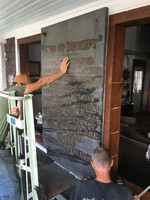By ETHAN HARTLEY -- The call of history is only getting louder at the Pawtuxet Rangers Armory, located on Remington Street in the heart of Pawtuxet Village...
This item is available in full to subscribers.
We have recently launched a new and improved website. To continue reading, you will need to either log into your subscriber account, or purchase a new subscription.
If you are a current print subscriber, you can set up a free website account by clicking here.
Otherwise, click here to view your options for subscribing.
Please log in to continue |
|

The call of history is only getting louder at the Pawtuxet Rangers Armory, located on Remington Street in the heart of Pawtuxet Village.
As work being conducted as part of another Eagle Scout project commenced on additional renovations made to the upstairs portion of the historic building – which is being converted into a robust museum featuring unique history from the area – downstairs in the main drill hall a gathering Sunday afternoon bore witness to the reveal of a historic plaque connected to true revolutionary roots of the burning of the Gaspee.
At six feet tall, 44 inches wide, an inch and a half thick and weighing in at 500 pounds, the enormous singular piece of slate dates back to 1891, once bookmarking a building that stood on the same plot where the historic Sabin Tavern once stood – the place where the burning of the Gaspee, the first major revolutionary act of the American Revolution, was planned by colonists in defiance of the British crown.
“Sons of Liberty,” the inscription begins with a large font at the top. “Upon this corner stood the Sabin Tavern, in which on the evening of June 9th, 1772 The Party met and organized to destroy H.R.M. Schooner Gaspee in the destruction of which was shed the first blood in the American Revolution.”
To Dr. John Concannon, historian for the Gaspee Days Committee, this attribution to the Sons of Liberty – a secret organization of rebellious colonists who opposed the Stamp Act of 1764 – is an important distinction to recognize.
Concannon said that, following the repeal of the Stamp Act, Sons of Liberty activists were looking for a catalyst to continue the momentum towards ultimate rebellion against the crown, and in 1772 they found such an opportunity.
“Lo and behold, the Gaspee turned up in Narragansett Bay, really ticking off the populace as something that represented continued taxation without representation of the crown against the colony,” Concannon said.
It could then be inferred that Sons of Liberty organizers helped orchestrate the premeditated attack on the Gaspee, which would be one of the major sparks prompting the American Revolution. Concannon said that the slate would have been erected on the building around the same time as the building that was constructed on the sight of the Sabin Tavern – known simply as the Gaspee Building.
“Those people who put this plaque on the Gaspee Building in 1891 knew the people who actually burned the Gaspee. They had first-hand stories told to them,” he said. “This plaque, the Sons of Liberty, it is written in stone – the actual Sons of Liberty helped burn the Gaspee.”
The slate’s journey to the Pawtuxet Rangers Armory was one that hinged on the coincidental interest of local individuals who didn’t want to see it be destroyed when the Gaspee Building was demolished in 1961.
It just so happened that Sharon Terzien, a former member of the Pawtuxet Rangers fife and drum corps and daughter of former Gaspee Days President Zack Terzien, saw a post from the Rangers about the slate and recognized it as the same artifact her father rescued from the building many years prior.
“She saw I posted this on Facebook and said, 'My dad is the one who rescued that, it sat in our back yard for years,'” explained Ron Barnes, Commander of the Pawtuxet Rangers. “That's Rhode Island, right?”
When Zack passed away, his wife sought someone to take the slate but ultimately it was left with the home when it was sold in 1974. The next owner preserved the slate and crated it in a warehouse, before it wound up back in someone else’s yard exposed to the elements.
However, it was a World War II veteran and Cranston resident, Raymond King McGehearty, who ultimately wound up with the slate permanently affixed on the wall of his home on Bridge Street. The Rangers were contacted if they’d be interested to accept the slate as a donation.
“We said absolutely, we would do it,” Barnes said. “The problem is, how do you move something that is 500 pounds and looks really fragile?”
Barnes hired Thornley DeGrasse Rigging, a company out of Pawtucket, to handle the delicate job. Utilizing a hydraulic jack, constructing a crate around the artifact and using a crane to lift the piece onto a truck and eventually into the armory hall, the riggers successfully mounted the slate onto the wall of the hall (with carpentry help from Jerry Peshka).
Appropriately, the slate now sits perfectly mounted directly next to the original door from the Sabin Tavern that has been a prized treasure for years at the Armory.
The cost of moving the heavy piece of history was $2,000 – and the Rangers hope to raise $2,500 to cover that cost and maintain the piece moving forward. The also hope to install some decent lighting around the slate, as the hall is a bit dark to see the details on the plaque.
“It's great that this piece of history has come back to our building,” said Barnes, who proceeded to be presented with a check from Concannon on behalf of the Gaspee Days Committee for $500 towards their fundraising goal.
Comments
No comments on this item Please log in to comment by clicking here